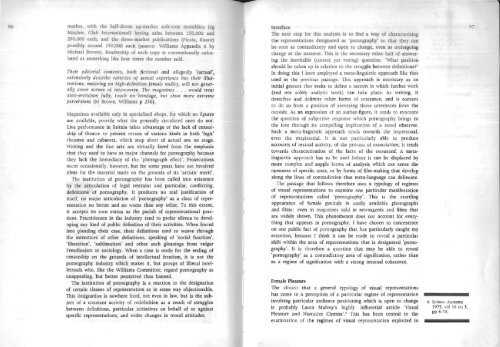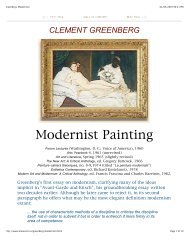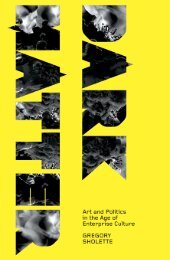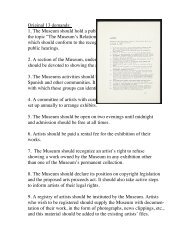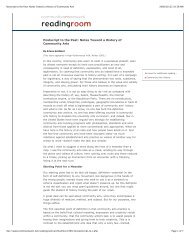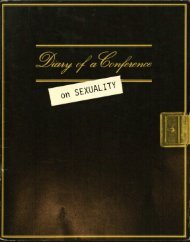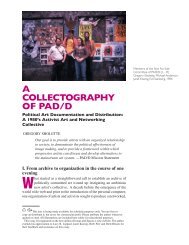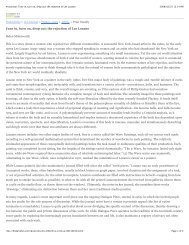Screen - Dark Matter Archives
Screen - Dark Matter Archives
Screen - Dark Matter Archives
Create successful ePaper yourself
Turn your PDF publications into a flip-book with our unique Google optimized e-Paper software.
96 market. with the half·dozen up·market soft·core monthlies (egMayfair. Club [PH"na'iona/) having sales between 150.000 and250.000 each. and 'he down·market publications (Fiesta. Knave)possibly around 150.000 each (source : Williams Ap pendix 6 byMichael Brown). Readership of each copy is conventionally calculatedat something like four times the number sold.Their editorial contents, both fictional and allegedly 'factual',extensively describe varieties of sexual experience but their illustrations,n1ajoring on high-definition female nudity. will not generallycover scenes of intercourse. Th e magazines . .. would treatauto-eroticism tully. touch on bondage, but shun more extremeperversio", (M Brown, Williams p 25 0).Magazines available only in specialised shops, for which no figuresarc available, provide what the ge nerally circulated ones do not.live performance in Britain takes advantage of the lack of censorshipof theatre to present revues of various kinds in both 'legit'theatres and cabarets, which stop short of anual sex on stage.Writing and the fine arts are vi rtually freed from the emphasisthat they used to have as major channels for pornography becausethey lack the immediacy of the 'pho tograph effect'. Prosecutionsoccur occasionally, however, but for some years have not involvedpleas fo r the material made on the grounds of its 'anistic merit'.The institution of pornography has been called inw existenceby the articulation of legal restraint and particular, contlicting,definitions of pornography. It produce s no real justification ofitself. no major articulation of 'pornography' as a class of repre·sentation no better and no wo rse than any other. To this extent,it accepts its own status as the pariah of representational prac·tices. Practitioners in tbe industry tend to prefer silence to developingany kind of public definition of their acdvities. \Vhen forcedinto pleading their case, their definitions tend to weave throughthe interstices of other definitions, speaking of 'social function','liberation', 'sublim ation' and other such gleanings from vulgarFreudianism or sociology. When a case is made fot the ending ofcensorship on the grounds of intellectual freedom, it is not thepornography industry which makes it. but groups of liberal incellecrualswho, like the Williams Committee, tega rd pornogtaphy asunappealing. but better permitted tha n banned.The institution of pornography is a reaction to the designationof certain classes of representation as in some way objectionable.Thjs designation is nowhere fixed, not even in law. but is the subjectof a constant activity of redefinition as a result of strugglesbetween definitions, particular initiatives on behalf of or againstspecific representations. and wider changes in moral attirudes.InterlaceThe next step for this analysis is to find a way of characterisingthe representations designated as 'pornography' so that tbey canbe- seen as contradic(Qry and open to change, even as undergoingcbange at tbe moment. This is the necessary other half of answer·ing the inevitable (correct yet vexing) question: 'What positionshould be taken up in relation to the struggle between definitions? 'In doing this I have employed a meta-linguistic approach like thatused in the previous passage. This approach is necessary as aninitial gesture that seeks to define a terrai n in which further work(and not solely analytic work) can take place. As writing. itdescribes and delimits other forms of utterance, and is contentto do so from a position of surveying those utterances from theoutside. As an expression of an author· figure, it tends to evacuatethe question of subjective response which pornography brings tothe fore through its compelling implication of a sexed observer.Such a meta·linguistic approach tends towards the impersonal,even the magisterial. It is not particularly able to produceaccounts of textual activity, of the process of enunciation; it tendstowards characterisation of the fa cts of the enoUtlCed. A meta·linguistic approach has to be used before it can be displaced bymore complex and supplc forms of analysis which can sense theopenness of specific [cxts. or by forms of fiIm·making that developalong the lines of conrradiction that meta-language can delineate.The passage that foll ows ,herefore uses a typology of regimesof visual representations to examine one particular manifestationof representations call ed 'pornography'. This is the smrtlingappeatance of female genitals in eaSily available photogtaphsand fi lms: even in magazines sol d in newsagents and films thatare widely shown. This phenomenon does not account for every·thing that appears in pornography. J have chosen to concentrateon one public fact of pornography that has particularly caught my3nendon, because I think it can be made to reveal a particularshift wi thin the area of representations that is designated ·porno·graphy'o It is therefore a question that may be able to reveal'pornography' as a contradictory area of signification, rather thanas a regime of signification with a strong internal coherence.FemaJe PleasureThe closest that a general typology of visual representationshas come to a perception of a particular regime of representationinvolving particular audience positioning which is open to changeis probably Laura Mulvey's highly influential article 'VisualPleasure and Narrative Cinema'.o This has been central to theexamination of the regimes of visual representation exploited in6 Sc reen Autu mn1975 . \/01 16 no 3,pp 6·18.97


